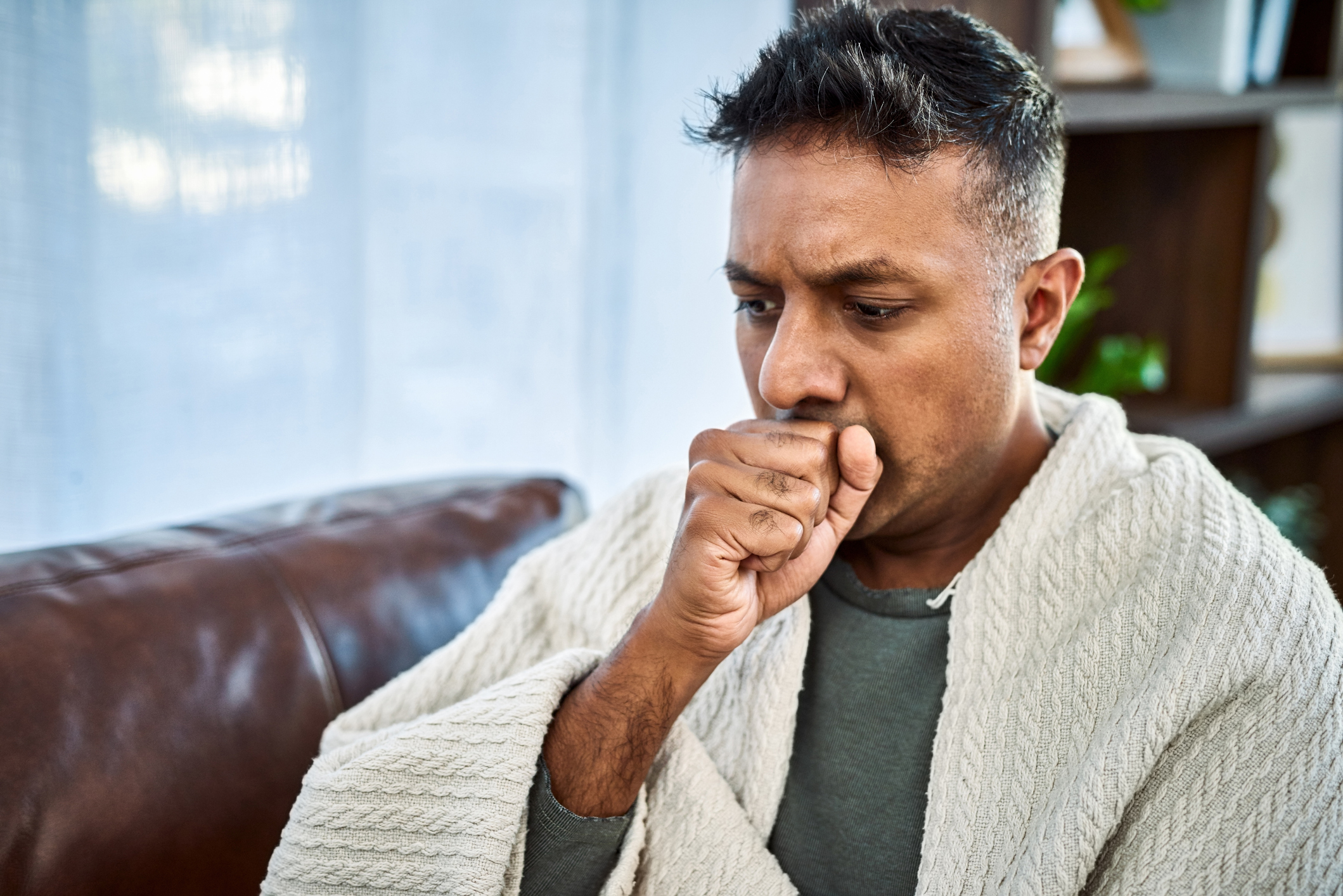At a glance
- Symptoms of certain fungal diseases, such as fever, cough and shortness of breath, can be similar to those of COVID-19.
- Consider testing patients with pneumonia who test negative for COVID-19 for fungal lung infections.
- COVID-19 can increase the risk for severe fungal infections, like COVID-19-associated pulmonary aspergillosis, mucormycosis, and invasive candidiasis.

Overview
COVID-19-associated fungal infections can lead to severe illness and death. Symptoms of certain fungal diseases can be similar to those of COVID-19, including:
- Fever
- Cough
- Shortness of breath

Some patients can have COVID-19 and a fungal infection at the same time. Laboratory testing is necessary to determine if a person has a fungal infection, COVID-19, or both.
COVID-19 likely increases the risk for fungal infections because of its effect on the immune system. Treatments for COVID-19 (like steroids and other drugs) can also weaken the body's defenses against fungi. The most commonly reported fungal infections in patients with COVID-19 include:
- Aspergillosis
- Invasive candidiasis
- Mucormycosis (or "black fungus")
Fungal infections resistant to antifungal treatment have also been described in patients with severe COVID-19.
Identifying a potential fungal co-infection with COVID-19 can reduce diagnosis and treatment delays. This will help prevent severe illness and death from these infections.
What the data shows
COVID-19-associated pulmonary aspergillosis
In the past, scientists thought aspergillosis only occurred in people with very weak immune systems. However, aspergillosis has been increasingly reported in patients with healthy immune systems who get severe respiratory infections. Several recent reports describe COVID-19-associated pulmonary aspergillosis (CAPA).
Available information indicates that CAPA:
- Usually occurs in patients with severe COVID-19 (e.g., patients on ventilators).
- Can be difficult to diagnose because patients display non-specific symptoms.
- Can be complex to test.
- Can cause severe illness and death.
Clinical considerations
Clinicians should consider aspergillosis in patients with severe COVID-19 who have worsening respiratory function or sepsis. This should occur even if they do not have classical risk factors for aspergillosis.
Testing for CAPA usually involves obtaining specimens from patients' lower respiratory tract, which are tested for Aspergillus galactomannan antigen and fungal culture. The treatment of CAPA includes antifungals like:
- Voriconazole
- Posaconazole
- Isavuconazole
Therapeutic drug monitoring should be considered when using these antifungals in CAPA treatment.
COVID-19-associated mucormycosis
Often called "black fungus," COVID-19-associated mucormycosis is a major public health problem in India. COVID-19-associated mucormycosis cases have also been seen outside of India, including in the United States, although much less commonly. Uncontrolled diabetes and overuse of steroids for COVID-19 treatment are important risk factors.
Clinical considerations
Biomarkers for diagnosing invasive aspergillosis, such as beta-d-glucan and galactomannan, are typically negative in patients with mucormycosis. The treatment for mucormycosis frequently involves aggressive surgical intervention and treatment with antifungals, including:
- Amphotericin B
- Posaconazole
- Isavuconazole
Voriconazole is not recommended for treating mucormycosis. Providers should consider therapeutic drug monitoring during COVID-19-associated mucormycosis treatment.
Prevention
The risk of COVID-19-associated mucormycosis can decrease by:
- Encouraging vaccination against COVID-19.
- Prescribing steroids for COVID-19 treatment based on guidelines.
- Controlling the blood sugar of patients with diabetes who have COVID-19.
Early diagnosis and treatment are key to improving outcomes for patients with COVID-19-associated mucormycosis. Clinicians should consider the possibility of mucormycosis in patients with COVID-19 even when patients lack classic risk factors for this disease.
Increased spread of Candida auris during COVID-19 pandemic
Candida auris (C. auris) is an emerging fungus that can cause outbreaks of severe infections in healthcare facilities. In the United States, it has most commonly spread in long-term care facilities with patients under severe medical conditions.
Since the start of the COVID-19 pandemic, outbreaks of C. auris have been reported in COVID-19 units of acute care hospitals. These outbreaks may be related to changes in routine infection control practices during the COVID-19 pandemic, including:
- Limited availability of gloves and gowns.
- Reuse or extended use of personal protective equipment.
- Changes in cleaning and disinfection practices.
Screening for C. auris colonization, an important part of containment efforts, has been more limited as healthcare facilities and health departments have been responding to COVID-19.
Invasive candidiasis in patients with COVID-19
Patients hospitalized for COVID-19 are at risk for healthcare-associated infections (HAIs), including candidemia, or bloodstream infections caused by Candida. Patients with COVID-19 who developed candidemia were less likely to have certain underlying conditions. Patients who underwent procedures commonly associated with candidemia were more likely to have acute risk factors linked to COVID-19 care, including medicines that suppress the immune system.
Fungal pneumonias can resemble COVID-19
Other fungal diseases, such as Valley fever (coccidioidomycosis), histoplasmosis, and blastomycosis, can cause fever, cough, and shortness of breath. These symptoms are similar to COVID-19 and bacterial pneumonias.
These fungi live in soil. People become infected by breathing in fungi present in the air. Clinicians should consider fungal pneumonias as a possible cause of respiratory illness, particularly if COVID-19 testing is negative. It is important to note that these fungal diseases can occur at the same time as COVID-19.
- Hoenigl M. Invasive fungal disease complicating COVID-19: when it rains it pours. Clin Infect Dis. 2020 Sep 5.
- Garcia-Vidal C, Sanjuan G, Moreno-García E, et al. Incidence of co-infections and superinfections in hospitalized patients with COVID-19: a retrospective cohort study. Clin Microbiol Infect. 2020 Jul 31.
- Lansbury L, Lim B, Baskaran V, Lim WS. Co-infections in people with COVID-19: a systematic review and meta-analysis. J Infect. 2020 May 27.
- Gangneux JP, Bougnoux ME, Dannaoui E, Cornet M, Zahar JR. Invasive fungal diseases during COVID-19: We should be prepared. J Mycol Med. 2020 Jun.
- Song G, Liang G, Liu W. Fungal co-infections associated with global COVID-19 pandemic: A clinical and diagnostic perspective from China. Mycopathologia. 2020 Jul 31.
- Koehler P, Cornely OA, Böttiger BW, Dusse F, Eichenauer DA, Fuchs F, et al. COVID-19 associated pulmonary aspergillosis. Mycoses. 2020 May 15.
- Chen N, Zhou M, Dong X, Qu J, Gong F, Han Y, et al. Epidemiological and clinical characteristics of 99 cases of 2019 novel coronavirus pneumonia in Wuhan, China: a descriptive study. Lancet. 2020 Jan 30.
- Beer KD, Jackson BR, Chiller T, Verweij PE, Van de Veerdonk FL, Wauters J. Does pulmonary aspergillosis complicate COVID-19? Crit Care Exp. 2020 Sep 18.
- Mohamed A, Rogers TR, Talento AF. COVID-19 associated invasive pulmonary aspergillosis: diagnostic and therapeutic challenges. J Fungi. 2020 Jul 22.
- Verweij PE, Gangneu J, Bassetti M, Bruggemann RJM, Cornely OA, Koehler P, et al. Diagnosing COVID-19-associated pulmonary aspergillosis. Lancet Microbe. 2020 May 10.
- Koehler P, Bassetti M, Chakrabarti A, Chen SCA, Colombo AL, Hoenigl M, et al. Defining and managing COVID-19-associated pulmonary aspergillosis: the 2020 ECMM/ISHAM consensus criteria for research and clinical guidance. Lancet. 2020 Dec 14.
- Dellière S, Dudoignon E, Fodil S, Voicu S, Collet M, Oillic P, et al. Risk factors associated with Covid-19-associated pulmonary aspergillosis in ICU patients: a French multicentric retrospective cohort. Clin Microbiol Infect. 2020 Dec 13.
- Marr KA, Platt A, Tornheim JA, Zhang SX, Datta K, Cardozo C, et al. Aspergillosis complicating severe coronavirus disease. Emerg Infect Dis. 2021 Jan.
- Benedetti MF, Alava KH, Sagardia J, et al. COVID-19 associated pulmonary aspergillosis in ICU patients: Report of five cases from Argentina. Med Mycol Case Rep. 2020 Dec 7.
- Arastehfar A, Carvalho A, van de Veerdonk, FL, Jenks JD, Koelher P, Krause R, et al. COVID-19 associated pulmonary aspergillosis (CAPA) – from immunology to treatment. J Fungi. 2020 Jun 24.
- CDC: Information for Healthcare Professionals About Aspergillosis.
- Nucci M, Barreiros G, Guimarães LF, Deriquehem VA, Castiñeiras AC, Nouér SA. Increased incidence of candidemia in a tertiary care hospital with the Covid-19 pandemic. Mycoses. 2020 Dec 4.
- Hughes S, Troise O, Mughal N, Moorse LSP. Bacterial and fungal coinfection among hospitalized patients with COVID-19: a retrospective cohort study in a UK secondary-care setting. Clin Microbiol Infect. 2020 Jun 27.
- Posteraro B, Torelli R, Vella A, Leone PM, De Angelis G, De Carolis E, et al. Pan-echinocandin-resistant Candida glabrata bloodstream infection complicating COVID-19: a fatal case report. J Fungi. 2020 Sep 6
- Meijer EFJ, Dofferhoff ASM, Hoiting O, Buil JB, Meis JF. Azole-resistant COVID-19-associated pulmonary aspergillosis in an immunocompetent host: a case report. J Fungi. 2020 Jun 6.
- Benedict K, Kobayashi M, Garg S, Chiller T, Jackson BR. Symptoms in blastomycosis, coccidioidomycosis, and histoplasmosis versus other respiratory illnesses in commercially insured adult outpatients, United States, 2016–2017. Clin Infect Dis. 2020 Oct 16.
- Shah AS, Heidari A, Civelli VF, Sharma R, Clark CS, Munoz AD, et al. The coincidence of 2 epidemics, coccidioidomycosis and SARS-CoV-2: a case report. J Investig Med High Impact Case Rep. 2020 Jun 4.
- Bertolini M, Mutti MF, Barletta JA, et al. COVID-19 associated with AIDS-related disseminated histoplasmosis: a case report. Int J STD AIDS. 2020 Sep 9.
- Rabagliati R, Rodríguez N, Núñez C, Huete A, Bravo S, Garcia P. COVID-19-Associated Mold Infection in Critically Ill Patients, Chile. Emerg Infect Dis. 2021 May.
- Garg D, Muthu V, Sehgal IS, Ramachandran R, Kaur H, Bhalla A, et al. Coronavirus Disease (Covid-19) Associated Mucormycosis (CAM): Case Report and Systematic Review of Literature. Mycopathologia. 2021 Feb 5.
- Kanwar A, Jordan A, Olewiler S, Wehberg K, Cortes M, Jackson BR. A Fatal Case of Rhizopus azygosporus Pneumonia Following COVID-19. JFungi. 2021 Feb 28.
- Cornely OA, Alastruey-Izquierdo A, Arenz D, et al. Global guideline for the diagnosis and management of mucormycosis: an initiative of the European Confederation of Medical Mycology in cooperation with the Mycoses Study Group Education and Research Consortium. The Lancet Infect Dis 2019 Nov 4.
- Mejía-Santos H, Montoya S, Chacón-Fuentes R, et al. Notes from the Field: Mucormycosis Cases During the COVID–19 Pandemic — Honduras, May–September 2021. MMWR Morb Mortal Wkly Rep. 2021 Dec 16.
- Dulski TM, DeLong M, Garner K, et al. Notes from the Field: COVID-19–Associated Mucormycosis — Arkansas, July–September 2021.MMWR Morb Mortal Wkly Rep. 2021 Dec 16.
- Raut A, Huy NT. Rising incidence of mucormycosis in patients with COVID-19: another challenge for India amidst the second wave? The Lancet RespMed. 2021 Aug.
- Baddley JW, Thompson GR 3rd, Chen SC, White PL, Johnson MD, Nguyen MH, et al. Coronavirus Disease 2019-Associated Invasive Fungal Infection. Open Forum Infect Dis. 2021 Nov 16.
- Narayanan S, Chua JV, Baddley JW. Coronavirus Disease 2019–Associated Mucormycosis: Risk Factors and Mechanisms of Disease. Clin InfectDis. 2021Aug 22.
- Janssen NAF, Nyga R, Vanderbeke L, Jacobs C, Ergün M, Buil JB, et al. Multinational Observational Cohort Study of COVID-19-Associated Pulmonary Aspergillosis. Emerg Infect Dis. 2021 Nov.
- Koehler P, Bassetti M , Chakrabarti A, Chen SCA, Lopes Colombo A, Hoenigl M, et al. Defining and managing COVID-19-associated pulmonary aspergillosis: the 2020 ECMM/ISHAM consensus criteria for research and clinical guidance. The Lancet Infect Dis. 2021 June.
- Yi WM, Schoeppler KE, Jaeger J, Mueller SW, MacLaren R, Fish DN, et al. Voriconazole and posaconazole therapeutic drug monitoring: a retrospective study. AnnClinMicrobiol Antimicrob. 2017 Sep 11.
- Patel A, Agarwal R, Rudramurthy SM, Shevkani M, Xess I, Sharma R, et al. Multicenter Epidemiologic Study of Coronavirus Disease–Associated Mucormycosis, India. Emerg Infect Dis. 2021 Sep.
- Pal R, Singh B, Bhadada SK, Banerjee M, Bhogal RS, Hage N, et al. COVID-19-associated mucormycosis: An updated systematic review of literature. Mycoses. 2021 June 16.
- Prestel C, Anderson E, Forsberg K, Lyman M, de Perio MA, Kuharet D, et al. Candida auris Outbreak in a COVID-19 Specialty Care Unit — Florida, July–August 2020. MMWR Morb Mortal Wkly Rep. 2021 Jan
